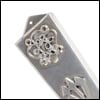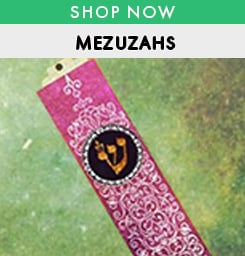The mezuzah's outer case can be lightly dusted. Never use liquid cleaners because they may seep within the case and damage the parchment scroll. Every three or four years, the scroll should be removed and inspected by a trained sofer to ensure that it has not become faded or damaged in any way that would diminish its sanctity and cause it to lose its protective power.
When removing the old mezuzah cases, the nails, screws and tape previously used to affix the mezuzahs may be discarded. However, mezuzah cases and mezuzah wrappings should be treated as sacred material and require genizah, interment, after their use.
Check Your Mezuzahs!
Mezuzahs should be checked by a sofer (certified scribe) twice every seven years to see if they have been affected by adverse weather conditions, or by folding (which can cause cracks in the letters), or if any other defect has occurred. It is preferable to check mezuzahs which are on the outside of a building more often, due to their vulnerability to inclement weather.
In addition, the infiltration of fraudulent mezuzahs in the marketplace present further cause for regular checking to determine the authenticity of the mezuzahs in your possession.
The checking of mezuzahs has been revolutionized by technological developments over the last several years. Mezuzahs can now be scanned by a computer for textual errors. Since no sofer, however diligent, is infallible, computer scanning has the advantage that no word or letter will ever be overlooked.
Utilization of the computer scanning method has brought serious instances of fraud to light. In one instance, for example, the system identified several mezuzahs as being exactly identical. This is impossible with handwritten parchments. Investigation revealed that the source was merely reproducing mezuzahs on parchment using a raised-ink printing process. In another instance, the system called attention to the fact that previously scanned mezuzahs with missing words or letters had been resubmitted with those errors corrected. Such a mezuzah is invalid, as it was written "out of order."
For this reason, in addition to having the mezuzah checked by a scribe, ask the scribe if he has the option to check it also via scanning the mezuzah into the computer.
There is an ancient custom practiced by people diligent in mitzvot to have their mezuzahs checked once a year, during the Jewish month of Elul, the month prior to the High Holidays. The Lubavitcher Rebbe, Rabbi Menachem Mendel Schneerson, of righteous memory, would encourage all to have their mezuzahs checked during this auspicious month.
A Blessing for Putting Back Up a Mezuzah?
When a mezuzah that has been removed — for checking, when renovations are being done, or for any other reason — is remounted, the blessing should be recited only if the mezuzah was off the doorposts for at least one night. If you are also adding new mezuzahs at this time, it is preferable to recite the blessing on a new one (providing that it is mounted on a door that requires a blessing).
It is preferred to have all of the mezuzahs returned to their original doorposts, or at least to the same type of entrance way (i.e., from one bedroom door to another, or from one archway to another).
A practical suggestion: when removing the mezuzahs, label each mezuzah case with a number (using masking tape or the like). Tape an identical number on the doorpost from which it was removed. If you are giving them to be checked, remember to request from the scribe to replace all mezuzahs in their original cases. When the mezuzahs are remounted, match the numbers from your cases to the numbers on the doorposts.







Join the Discussion